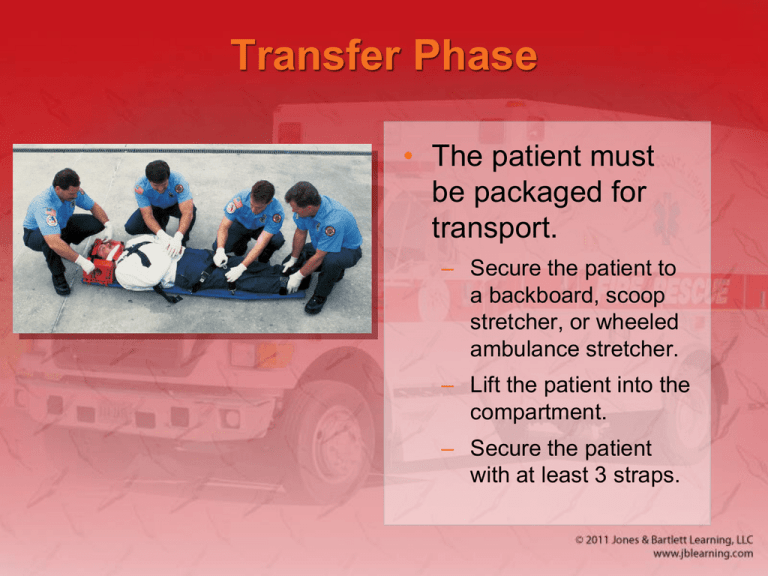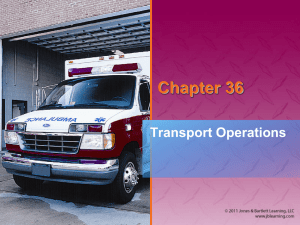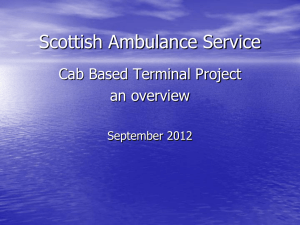Chapter 36 PPT part 2
advertisement

Transfer Phase • The patient must be packaged for transport. – Secure the patient to a backboard, scoop stretcher, or wheeled ambulance stretcher. – Lift the patient into the compartment. – Secure the patient with at least 3 straps. Transport Phase (1 of 2) • Excessive speed is unnecessary and dangerous. • When you are ready to leave with the patient, inform dispatch of: – Number of patients – Name of receiving hospital – Beginning mileage of ambulance Transport Phase (2 of 2) • Monitor the patient’s condition en route. – Recheck a stable patient every 15 minutes. – Recheck an unstable patient every 5 minutes. • Contact the receiving hospital. • Do not abandon the patient emotionally. Delivery Phase • Notify dispatch of your arrival at the hospital. • Report your arrival to the triage nurse. • Physically transfer the patient. • Present a complete verbal report. • Complete a detailed written report. • Restock items, if possible. En Route to the Station • Inform dispatch whether you are in service and where you are going. • Back at the station: – Clean and disinfect the ambulance and equipment. – Restock supplies. Postrun Phase (1 of 6) • Complete and file additional written reports. • Inform dispatch again of status, location, and availability. • Perform routine inspections. • Refuel the vehicle. Postrun Phase (2 of 6) • Important to know the meaning of the following terms: – Cleaning: The process of removing dirt, dust, blood, or other visible contaminants from a surface or equipment – Disinfection: The killing of pathogenic agents by directly applying a chemical made for that purpose to a surface or equipment Postrun Phase (3 of 6) • Important to know the meaning of the following terms (cont’d) – High-level disinfection: The killing of pathogenic agents by the use of potent means of disinfection – Sterilization: A process, such as the use of heat, that removes all microbial contamination Postrun Phase (4 of 6) • After each call: – Strip linens from the stretcher and place them in a plastic bag or designated receptacle. – Discard medical waste. – Wash contaminated areas with soap and water. Postrun Phase (5 of 6) • After each call (cont’d): – Disinfect all nondisposable equipment used for patient care. – Clean the stretcher with germicidal/virucidal solution or 1:100 bleach dilution. – Clean spillage or other contamination with one of those same solutions. Postrun Phase (6 of 6) • Create a schedule for routine full cleaning of the emergency vehicle. • Create a written policy/procedure for cleaning each piece of equipment. Defensive Ambulance Driving Techniques (1 of 11) • Over 6,000 ambulance crashes occur each year, some of which are fatal. Source: © Gary Lloyd, The Decatur Daily/AP Photos • An ambulance involved in a crash delays patient care, at a minimum. Defensive Ambulance Driving Techniques (2 of 11) • Driver characteristics – Some states require an emergency vehicle operations course. – Physical fitness and alertness are necessary. – Emotional maturity and stability – Respect for other motorists. Defensive Ambulance Driving Techniques (3 of 11) • Safe driving practices – Speed does not save lives; good care does. – Wear seatbelts and shoulder restraints. – Become familiar with how the vehicle accelerates, corners, sways, and stops. – Stay in the extreme left-hand lane on multilane highways. Defensive Ambulance Driving Techniques (4 of 11) Defensive Ambulance Driving Techniques (5 of 11) • Siren risk-benefit analysis – The decision to activate the emergency lighting and sirens will depend on: • Local protocols • Patient condition • Anticipated clinical outcome of the patient Defensive Ambulance Driving Techniques (6 of 11) • Driver anticipation – Always assume that motorists around your vehicle have not heard your siren/public address system or seen you. – You must always drive defensively. Defensive Ambulance Driving Techniques (7 of 11) • The cushion of safety – Maintain a safe following distance from the vehicles in front of you. – Try to avoid being tailgated from behind. – Ensure that the blind spots do not prevent you from seeing vehicles or pedestrians. – Never get out of the ambulance to confront a driver. Defensive Ambulance Driving Techniques (8 of 11) • The problem of excessive speed – Unnecessary, dangerous, and does not increase the patient’s chance of survival – Makes it difficult to provide care in the patient compartment – Hinders driver’s reaction time – Increases time and distance needed to stop the ambulance Defensive Ambulance Driving Techniques (9 of 11) • Recognition of siren syndrome – Siren syndrome causes drivers to drive faster in the presence of sirens, due to increased anxiety. • Vehicle size and distance judgment – Crashes often occur when the vehicle is backing up, so use a spotter. – Size and weight influence braking and stopping distances. Defensive Ambulance Driving Techniques (10 of 11) • Road positioning and cornering – To keep the ambulance in the proper lane when turning, enter high in the lane, and exit low. Defensive Ambulance Driving Techniques (11 of 11) • Weather and road conditions – Ambulances have a longer braking time and stopping distance. – The weight of the ambulance is unevenly distributed, which makes it more prone to roll over. – Be alert for hydroplaning, water on the roadway, decreased visibility, and ice and slippery surfaces. Laws and Regulations (1 of 5) • If you are on an emergency call and are using your warning lights and siren, you may be allowed to do the following: – Park or stand in an illegal location – Proceed through a red light or stop sign – Drive faster than the speed limit – Drive against the flow of traffic – Travel left of center to make an illegal pass Laws and Regulations (2 of 5) • An emergency vehicle is never allowed to pass a school bus that has stopped to load or unload children. • Use of warning lights and siren – Unit must be on a true emergency call – Both audible and visual warning devices must be used simultaneously. – Unit must be operated with regard for others’ safety Laws and Regulations (3 of 5) • Right-of-way privileges – Emergency vehicles have the right to disregard the rules of the road when responding to an emergency. – Do not endanger people or property under any circumstances. – Get to know your local right-of-way privileges. Laws and Regulations (4 of 5) • Use of escorts – Only use as a guide when you are in unfamiliar territory • Intersection hazards – Intersection crashes are the most common and most serious. – If you cannot wait for traffic lights to change, still come to a momentary stop. Laws and Regulations (5 of 5) • Highways – Shut down emergency lights and sirens until you have reached the far left lane. • Unpaved roads – Operate at a lower speed with a firm grip on the steering wheel. • School zones – It is unlawful to exceed the speed limit. Distractions • Focus on driving and anticipating roadway hazards. • Minimize distractions from: – Mobile dispatch terminals and GPS – Mounted mobile radio – Stereo – Cell phone – Eating/drinking Driving Alone • It is your responsibility to focus on figuring out the safest route while mentally preparing for the call. • Situations such as these demand your complete attention and focus. Fatigue • Recognize when you are fatigued, and alert your partner or supervisor. • You should be placed out of service for the remainder of the shift or until the fatigue has passed and you feel capable of operating the vehicle safely. Source: Courtesy of Ed Edahl/FEMA Source: © Ralph Duenas/www.jetwashimages.com Air Medical Operations (1 of 11) • Air ambulances are used to evacuate medical and trauma patients. – Fixed-wing units – Rotary-wing units (helicopters) Air Medical Operations (2 of 11) • Specially trained crews accompany air ambulance flights. – EMTs provide ground support. • Medical evacuation (medivac) is performed by helicopters. – Capabilities, protocols, and procedures vary. Air Medical Operations (3 of 11) • Why call for a medivac? – Transport time by ground is too long. – Road, traffic, or environmental conditions prohibit the use of ground transport. – Patient requires advanced care. – Multiple patients will overwhelm resources at the hospital reachable by ground transport. Air Medical Operations (4 of 11) • Who receives a medivac? – Patients with time-dependent injuries or illnesses – Stroke, heart attack, or spinal cord injury – Scuba diving accidents, near-drownings, or skiing and wilderness accidents – Trauma patients – Candidates for limb replantation, burn center, hyperbaric chamber, or bite center Air Medical Operations (5 of 11) • Whom do you call? – Generally, the dispatcher should be notified first. – In some regions, EMS may be able to communicate with the flight crew after initiating the medivac request. Air Medical Operations (6 of 11) • Establish a landing zone. – Hard or grassy level surface between 60 × 60 and 100 × 100 (recommended) – Cleared of loose debris – Alert the flight crew of overhead or tall hazards. – Mark the landing site using cones or vehicles. Air Medical Operations (7 of 11) • Establish a landing zone (cont’d). – Move nonessential persons and vehicles. Source: © Mark C. Ide – Communicate the direction of strong wind to the flight crew. Air Medical Operations (8 of 11) • Landing zone safety and patient transfer – Keep a safe distance from the aircraft whenever it is on the ground and “hot.” – Stay away from the tail rotor. – Never approach the helicopter from the rear. Air Medical Operations (9 of 11) Air Medical Operations (10 of 11) • Keep the following guidelines in mind: – Become familiar with hand signals. – Do not approach the helicopter unless instructed and accompanied by flight crew. – Make certain that all equipment and the patient are secured to the stretcher. – Side- vs. rear-loading doors – Smoking, open lights or flames, and flares are prohibited within 50′. Air Medical Operations (11 of 11) Special Considerations (1 of 3) • Night landings – Do not shine spotlights, flashlights, or any other lights in the air to help the pilot. – Direct low-intensity headlights or lanterns toward the ground. – Illuminate overhead hazards or obstructions, if possible. Special Considerations (2 of 3) • Landing on uneven ground – The main rotor blade will be closer to the ground on the uphill side. – Approach from the downhill side only. Special Considerations (3 of 3) • Medivacs at hazardous materials incidents – Notify the flight crew. – Consult about the best approach and distance from the scene. – Landing zone should be uphill and upwind. – Decontaminate patients before loading them into the helicopter. Medivac Issues (1 of 2) • Assess the severity of the weather or environment/terrain. • Most helicopters are limited to flying at 10,000′ above sea level. • Medivac helicopters fly between 130 and 150 mph. Medivac Issues (2 of 2) • Because of the cabin’s confined space, assess the number and size of the patients that can be safely transported in a medivac helicopter. • Typical medivac flights cost between $8,000 and $10,00. – Ambulance transport costs $400 to $1,000.







